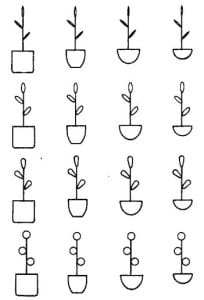Conscious or not, we are faced with countless categorization decisions during our everyday lives. When organizing kids’ rooms, parents need to decide if various items are tools or toys, to know in which drawer to place them. On a visit to the pet store, visitors can take pleasure in the activity of identifying various pets they see as cats or dogs. In geometry classes, students are taught how to tell squares apart from rectangles. No matter how fast and intuitive some categorizations may feel, the process of making any classification decision involves a chain of cognitive steps. Although the exact cognitive processes are different for everyone, the decision to categorize something ultimately comes down to comparing a handful of features or characteristics of different categories to find the one in which the object fits. For example, when asked how to distinguish between cats and dogs, some people may say that cats tend to have longer, fluffy tails whereas dogs have shorter, stiff tails. Psychologists believe that features as such, whether quantitative (e.g., tail length) or qualitative (e.g., presence of dense fur on the tail), underlines how the human mind categorizes various natural objects.
As scientists, we try to figure out the ways humans categorize all sorts of objects. We conduct experiments that simulate real-life categorization tasks and then develop computational models of human behavior, which give us insight into the cognitive processes driving the behavior. Pre-existing knowledge on various types of natural objects can have substantial effects on the results of the study, so we often conduct experiments that use artificially constructed objects with a few features we can manipulate.

To see how we measure how similar or different two objects are, look at the image to the right. As you can see in this image of potted plants, the pot gets “rounder” as you go from left to right, and the leaves get more circular as you go from top to bottom. How do we compare how similar the pots are? You can simply draw a line between two pots; the shorter the line, the more similar they are.
Psychologists generally have three ways of thinking about the cognitive processes involved in categorization. The first theory is called “exemplar theory.” It assumes that when deciding whether a new item belongs to a specific category, we compare it to all the examples of that category and other alternative categories that we have learned in the past. We use this comparison to determine whether the new item is more similar to the examples of the target category or to those of the contrasting categories.
For example, the exemplar theory gives a reasonable explanation of how a house item is usually classified into a tool or a toy. First, it is important to bear in mind that the terms “tool” and “toy” refer to a broad range of objects that are very different between one another. As a specific example, a hammer and a tape measure are both tools but look very different; on the other hand, a doll and a Lego piece are both toys but seem very different. Hence, no single object can be picked out as a representative of either category. So instead, people tend to classify a novel item, such as a pretend hammer made of Lego pieces, by comparing it with a more familiar similar-looking example of a tool, in this case a real hammer or a toy, such as a Lego-made screwdriver.
In contrast, the “prototype theory” states that the category evidence is determined by the similarity to a single summary representation (i.e., prototype) for each category. An example would be the distinction between cats and dogs, where the two groups of pets are each marked by a representative example.
Thirdly, “rule-based theory” claims that category membership is explicitly defined in terms of individual feature values so that a novel item can be categorized in isolation with reference to the feature-based rules. Such mode of categorization is more commonly seen in scientific definitions than in naturally occurring object types. For example, by definition, squares are distinguished from rectangles by the feature of equal side length.
Importantly, categorization in real life is very dynamic and flexible, and none of the three theories by itself can fully explain the way that humans categorize things. As such, these theories are treated more as standard templates that can be borrowed, combined, and customized to describe the core cognitive mechanisms in various categorization experiments. To give a few examples, a hybrid prototype-exemplar model can postulate that categorization is primarily driven by the similarity comparison to the category prototypes except that when a novel item is sufficiently close to some exemplar, the prototype of the target category is replaced by that exemplar. A hybrid exemplar-rule model can assume that the category rule defines an ambiguous region in the feature space where the categorization is delegated to an exemplar-based mechanism.
I have barely scratched the surface of decades of scientific inquiry on human categorization. Although the classical theories of categorization served well as elegant and powerful accounts of categorization performance in behavioral experiments, they still have a long way to go to fully characterize human categorization in natural contexts. With the fundamental nature of categorization mechanisms sorted out, psychologists in the field now turn their attention to more difficult and intriguing questions such as how the perception of similarity between existing category examples evolve as a function of learning more about the overall category structure.
References:
Edited by Taylor Woodward and Brianna Best

Leave a Reply